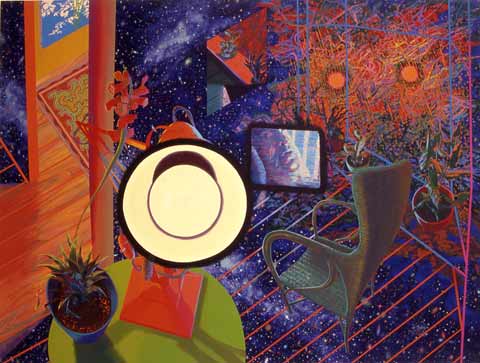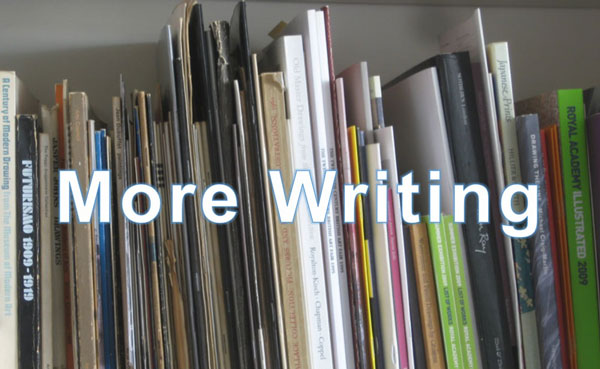
David Royle







Printed Catalogue available
£5 + p.p.
(request)
£5 + p.p.
(request)
From: "The best-kept arts secrets in Britain"
The Observer, Sunday 17th September 2006
A.S. Byatt, Novelist, on David Royle, Painter.
David Royle has been painting for more than
30 years now, brilliant and subtle paintings
which explore space and colour in new
ways. He is one of a generation of excellent
painters whose work has been less available
than they deserve, owing to fashions for
installations, videos and so on. At the moment
he is painting domestic things transfigured in a
kind of cosmic space looming and spreading
outside fragile walls. He is brilliant with the
garish colours of urban worlds. He is delicate
with surfaces of water and hidden depths.
David Royle
Moving Matisse's Furniture
and
Other Paintings
Moving Matisse's Furniture
and
Other Paintings


These famous photographs by Héléne Adant (Paris) were taken in Matisse's house, Le Rêve, in the south of France.
Moving Matisse’s Furniture
Living in his house, Le Rêve (the Dream), in the south of
France, Henri Matisse continued to work through the
Second World War in a country ruled by its Vichy
government and subject to the German occupation. Little
of this political and social upheaval showed in his
paintings. I had already been working on some paintings
of expanded domestic interiors and Matisse’s famous
comment about painting, which included his
“comfortable armchair” analogy, kept coming to my mind.
Around 2004 I began to consider making paintings that
placed some of Matisse’s personal domestic furniture into
more agitated contexts, disturbing the dream.
These paintings sit centrally in a larger body of works in
which the domestic interior spaces are rendered
transparent and open to the outside, to strangely lit
cityscapes or more chaotic and uneasy vistas.
D.R.
Le Rêve Perturbé 2004
Oil paint on linen 183 x 137 cm
Oil paint on linen 183 x 137 cm



Darkness Visible 2004 (Private Collection)
Oil paint on linen 152 x 122 cm
Oil paint on linen 152 x 122 cm
Strange Weather 2007
Oil paint on linen 137 x 122 cm
Oil paint on linen 137 x 122 cm



Three Armchairs for Mr. M. 2004
Oil paint on linen 152.5 x 152.5 cm
Oil paint on linen 152.5 x 152.5 cm
Related Paintings…a continuation
There is a well-upholstered comfort, even a bourgeois
opulence, to some of Matisse’s furniture but domestic ease
cannot provide much of a barrier to more overwhelming
exterior forces. Some of this sense of domestic ease, even luxury,
is continued and disturbed in the paintings Pandaemonium,
Hotel Pandaemonium and A Dark Inversion. In The Raft and
Proliferation the interiors are set adrift, raft-like, on an agitated
surface of blue or yellow random image fragments.
In Overview and Overview 2 the enlarged details at the edges
of the canvas create a simplified sense of a window through
which we see out and down and in Moonbeam and Sunbeam
the interiors have been concentrated down to just a small
group of domestic objects, a shelf and a patch of wall, caught
in a beam of window-light.
D.R.




Pandaemonium 2004
Oil paint on linen 190.5 x 167.5 cm
Oil paint on linen 190.5 x 167.5 cm
The Raft 2005
Oil paint on linen 180.5 x 185.5 cm
Oil paint on linen 180.5 x 185.5 cm
Raft 2005
Oil paint on linen 114.5 x 91.5 cm
Oil paint on linen 114.5 x 91.5 cm




Raft 2005
Oil paint on linen 114.5 x 91.5 cm
Oil paint on linen 114.5 x 91.5 cm
Proliferation 2005
Oil paint on linen 190.5 x 244 cm
Oil paint on linen 190.5 x 244 cm



Hotel Pandaemonium 2005 (Private Collection)
Oil paint on linen 114.4 x 91.5 cm
Oil paint on linen 114.4 x 91.5 cm
A Dark Inversion 2006 (Private Collection)
Oil paint on linen 91.5 x 91.5 cm
Oil paint on linen 91.5 x 91.5 cm







Overview 2005 (Private Collection)
Oil paint on linen 114.5 x 91.5 cm
Oil paint on linen 114.5 x 91.5 cm
Overview, No 2 2005
Oil paint on linen 81 x 101.5 cm
Oil paint on linen 81 x 101.5 cm


Moonbeam 2007
Oil paint on linen 142.5 x 101.5 cm
Oil paint on linen 142.5 x 101.5 cm
Sunbeam 2007
Oil paint on linen 114 .5 x 91.5 cm
Oil paint on linen 114 .5 x 91.5 cm
Some earlier paintings…setting-up the room
My studio is on the second floor of a building overlooking a busy
road. I suspect that it was this physical location that I gradually
internalised to become the imagined space for many of these
paintings. Before I made the “Matisse paintings “ I had already
been making paintings that combined the intimacy of domestic
spaces with wider vistas seen through apparently transparent
walls, often with a sense of being high up and looking out and
down. The floors and walls become minimal and linear and give
way to extended urban views. The linear space of the interiors is
also tipped-up and rearranged to bring it forward and to give the
viewer a close-in imaginary viewpoint. There is little sense of
protection or of a barrier between the interior and the exterior.
This is the world of Exposure, Nightlights, Night Vision and After
Day’s End. There is a negative quality to the light and the colours
are moved towards the synthetic: magentas, scarlets, some acid
yellow and the green of night-vision lenses. The city is endlessly
active and something strange may be happening.
A short walk from the studio is a steeply stepped open girder
footbridge which crosses the Great Western railway tracks. Its local
nickname is “Jacob’s Ladder”. This is the source of the titles
Jacob’s Ladder I and Jacob’s Ladder II but there are no angels
rising and descending these steps.
D.R.

Exposure 2002
Oil paint on linen 137 x 152.5 cm
Oil paint on linen 137 x 152.5 cm






Nightlights 2003
Oil paint on linen 137 x 152.5 cm
Oil paint on linen 137 x 152.5 cm
Night Vision 2003
Oil paint on linen 137 x 152.5 cm
Oil paint on linen 137 x 152.5 cm


After Day’s End 2003
Oil paint on linen 137 x 133.5 cm
Oil paint on linen 137 x 133.5 cm
Jacob’s Ladder I 2003
Oil paint on linen 183 x 137 cm
Oil paint on linen 183 x 137 cm





Jacob’s Ladder II 2003
Oil paint on linen 183 x 137 cm
Oil paint on linen 183 x 137 cm
Precursors
History is written looking backwards. Our viewpoint, where we stand or what we
focus on as an ending, becomes a beginning for the shaping of a pattern.
When the painting “Living-Room” was made in 1999 it stood isolated in a run of more
elementally themed work: imagery of fire and water, canal weir edges, floating
vegetation and reflecting surfaces. It looked like an anomaly. Twenty-three
paintings later I made “Inside on a Wild Night” which picks up and develops the
construction of “Living-Room”. Almost immediately afterwards followed the
paintings based on our French summer stays at Villa Maria in the Cévennes of which
“Summertime Flies at Villa Maria” is an example.
If the Villa Maria paintings were more sunny and gentle the interior/exterior paintings
that followed were far more precarious and vulnerable. These are the “Falling
paintings” made after the deaths and the destruction of the twin towers’ collapse in
New York. In “Kitchen Freeze-Frame” and in “All Falling Freeze-Frame” the interior
spaces are kitchens: routine and ordinary, even banal, spaces. They are extremely
exposed and through their sparsely delineated walls are views of falling, caught as
though on a video freeze-frame, with the sort of visual distortion often occurring on
old V.H.S. tapes. Ordinary living crashed by the big event.
With these paintings the pattern of continuing work, which will later have the
“Matisse’s furniture” paintings at its centre, is well established. Writing about this
entire sequence of paintings A.S. Byatt got it exactly right using the words “fragile”
and “looming”. The interior walls are fragile, the domestic comfort is no barrier to
what is out there, looming elsewhere and beyond.
D.R.


Kitchen Freeze-Frame 2002
Oil paint on linen 180.5 x 178 cm
Oil paint on linen 180.5 x 178 cm
All Falling Freeze-Frame 2002
Oil paint on linen 152.5 x 152.5 cm
Oil paint on linen 152.5 x 152.5 cm







Summertime Flies at Villa Maria 2000
Oil paint on linen 132 x 167.5 cm
Oil paint on linen 132 x 167.5 cm
Inside on a Wild Night 2000
Oil paint on linen 137 x 183 cm
Oil paint on linen 137 x 183 cm
Living-Room 1999
Oil paint on linen 121 x 182 cm
Oil paint on linen 121 x 182 cm
Postscript - (Hi)storylines
Repeating myself - history is written looking backwards. Our
viewpoint, where we stand or what we focus on as an ending
becomes a beginning for the shaping of a pattern -
a storyline/historyline.
This catalogue was made to accompany an exhibition in June 2018
at the Art Bermondsey Project Space Gallery, London, showing a
small selection from the works illustrated here. The starting and
central viewpoint for this exhibition was the Matisse’s furniture
paintings, how they developed afterwards and how they were
anticipated by earlier paintings. The paintings illustrated here were
made between 1999 and 2007. There were more and different
paintings made alongside them, many more works made since and
many more works made before them.
Looking back now, from my viewpoint in 2018, it is possible to discern
several other differing patterns of relationship and development
running through all of the work - differing (hi)storylines. The paintings
selected for this catalogue represent just one of these possible
patterns. There are more.
D.R. 2018



David Royle was born in Manchester and after a few years moved, with his
family, to Blackpool on the Lancashire coast. Eventually he made his own move
south to study Fine Art at the Central School of Art & Design in London. While still
studying at the Central School he established his own studio in west London,
where he continued to work after graduating.
He has shown regularly in London and elsewhere in the U.K. and in Switzerland. His
work has also been included in many mixed exhibitions and art fairs and has been
featured and reviewed in the art press, the national press and on radio and
television. It is included in several private and corporate collections at home and
abroad and in several British public collections, among which are: the Arts
Council, the British Museum and Chelsea & Westminster Hospital.
In addition he is also an experienced Art School lecturer, teaching first at
Winchester School of Art and then at Croydon College, Central Saint Martins and
Kingston University. He has also lectured on colour at Tate Britain and teaches
occasional short courses and summer schools at Central Saint Martins.
www.davidroyle.com
All reproductions of paintings © David Royle 2018


